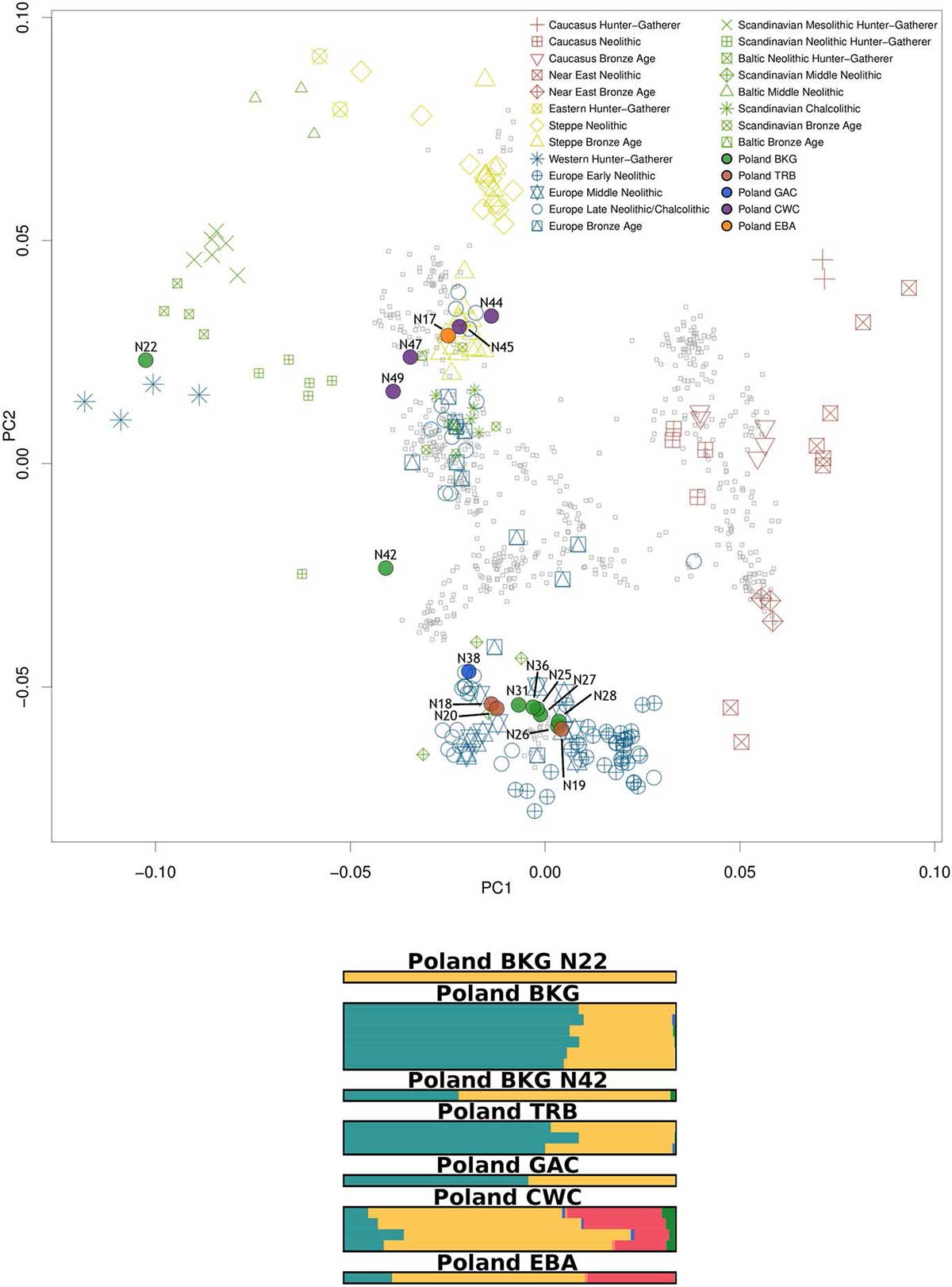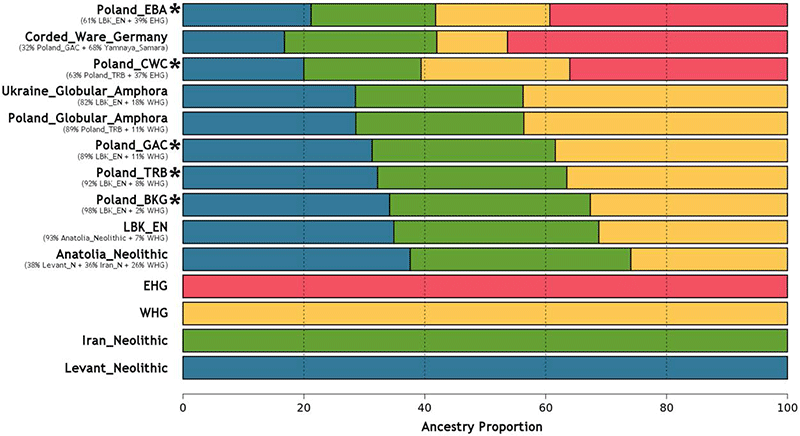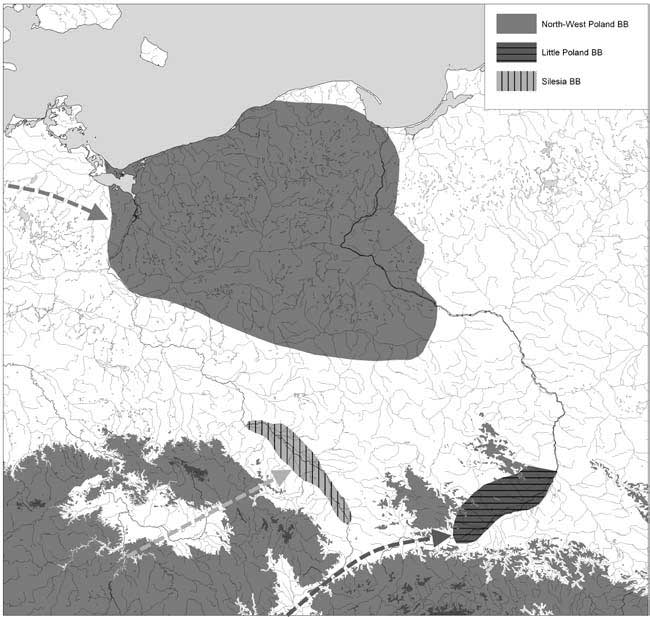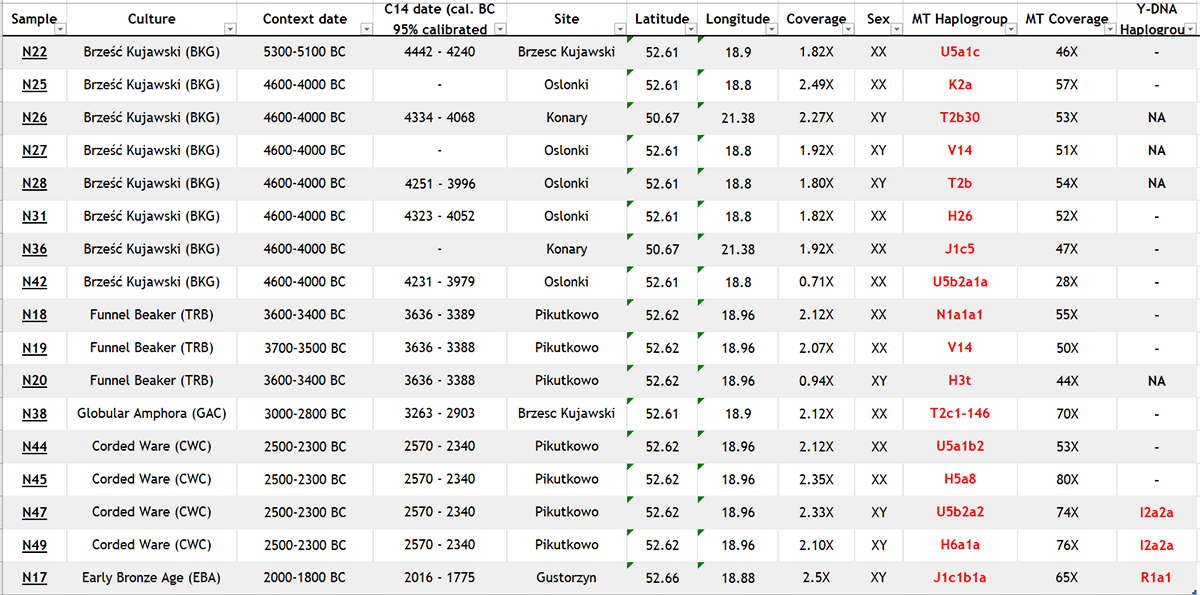Open access A genomic Neolithic time transect of hunter-farmer admixture in central Poland, by Fernandes et al. Scientific Reports (2018).
Interesting excerpts (emphasis mine, stylistic changes):
Most mtDNA lineages found are characteristic of the early Neolithic farmers in south-eastern and central Europe of the Starčevo-Kőrös-Criş and LBK cultures. Haplogroups N1a, T2, J, K, and V, which are found in the Neolithic BKG, TRB, GAC and Early Bronze Age samples, are part of the mitochondrial ‘Neolithic package’ (which also includes haplogroups HV, V, and W) that was introduced to Europe with farmers migrating from Anatolia at the onset of the Neolithic17,31.
A noteworthy proportion of Mesolithic haplogroup U5 is also found among the individuals of the current study. The proportion of haplogroup U5 already present in the earliest of the analysed Neolithic groups from the examined area differs from the expected pattern of diversity of mtDNA lineages based on a previous archaeological view and on the aDNA findings from the neighbouring regions which were settled by post-Linear farmers similar to BKG at that time. A large proportion of Mesolithic haplogroups in late-Danubian farmers in Kuyavia was also shown in previous studies concerning BKG samples based on mtDNA only, although these frequencies were derived on the basis of very small sample sizes.
A significant genetic influence of HG populations persisted in this region at least until the Eneolithic/Early Bronze Age period, when steppe migrants arrived to central Europe. The presence of two outliers from the middle and late phases of the BKG in Kuyavia associated with typical Neolithic burial contexts provides evidence that hunter-farmer contacts were not restricted to the final period of this culture and were marked by various episodes of interaction between two societies with distinct cultural and subsistence differences.
The identification of both mitochondrial and Y-chromosome haplogroup lineages of Mesolithic provenance (U5 and I, respectively) in the BKG support the theory that both male and female hunter-gatherers became part of these Neolithic agricultural societies, as has been reported for similar cases from the Carpathian Basin, and the Balkans. The identification of an individual with WHG affinity, dated to ca. 4300 BCE, in a Middle Neolithic context within a BKG settlement, provides direct evidence for the regional existence of HG enclaves that persisted and coexisted at least for over 1000 years, from the arrival of the LBK farmers ca. 5400 BCE until ca. 4300 BCE, in proximity with Neolithic settlements, but without admixing with their inhabitants.

The analysis of two Late Neolithic cultures, the GAC and CWC, shows that steppe ancestry was present only among the CWC individuals analysed, and that the single GAC individual had more WHG ancestry than previous local Neolithic individuals. (…) The CWC’s affinity to WHG, however, contrasts with results from published CWC individuals that identified steppe ancestry related to Yamnaya as the major contributor to the CWC genomes, while here we report also substantial contributions from WHG that could relate to the late persistence of pockets of WHG populations, as supported by the admixture results of N42 and the finding of the 4300-year-old N22 HG individual. These results agree with archaeological theories that suggest that the CWC interaction with incoming steppe cultures was complex and that it varied by region.
Some comments
About the analyzed CWC samples, it is remarkable that, even though they are somehow related to each other, they do not form a tight cluster. Also, their Y-DNA (I2a), and this:
When compared to previously published CWC data, our CWC group (not individuals) is genetically significantly closer to WHG than to steppe individuals (Z = −4.898), a result which is in contrast with those for CWC from Germany (Z = 2.336), Estonia (Z = 0.555), and Latvia (Z = 1.553).

Włodarczak (2017) talks about the CWC period in Poland after ca. 2600 BC as a time of emergence of an allochthnous population, marked by the rare graves of this area, showing infiltrations initially mainly from Lesser Poland, and later (after 2500 BC) from the western Baltic zone.
Since forest sub-Neolithic populations would have probably given more EHG to the typical CWC population, these samples support the resurge of ‘local’ pockets of GAC- or TRB-like groups with more WHG (and also Levant_Neolithic) ancestry.
The known presence of I2a2a1b lineages in GAC groups in Poland also supports this interpretation, and the subsistence of such pockets of pre-steppe-like populations is also seen with the same or similar lineages appearing in comparable ‘resurge’ events in Central Europe, e.g. in samples from the Únětice and Tumulus culture.
About the Bronze Age sample, we have at last official confirmation of haplogroup R1a1a (sadly no subclade*) at the very beginning of the Trzciniec period – in a region between western (Iwno) and eastern (Strzyżów) groups related to Mierzanowice – , which has to be put in relation with the samples from the final Trzciniec period in the Baltic published in Mittnik et al. (2018).
EDIT (8 OCT 2018): More specific subclades have been published, including a R1a-Z280 lineage for the Bronze Age sample (see spreadsheet).
This confirms the early resurge of R1a-Z645 (probably R1a-Z282) lineages at the core of the developing East European Bronze Age, a province of the European Bronze Age that emerged from evolving Bell Beaker groups in Poland.

I don’t have any hope that the Balto-Slavic evolution through BBC Poland → Mierzanowice/Iwno → Trzciniec → Lusatian cultures is going to be confirmed any time soon, until we have a complete trail of samples to follow all the way to historic Slavs of the Prague culture. However, I do think that the current data on central-east Europe – and the recent data we are receiving from north-east Europe and the Iranian steppes, at odds with the Indo-Slavonic alternative – supports this model.
I guess that, in the end, similar to how the Yamna vs. Corded Ware question is being solved, the real route of expansion of Proto-Balto-Slavic (supposedly spoken ca. 1500-1000 BC) is probably going to be decided by the expansion of either R1a-M458 (from the west) or R1a-Z280 lineages (from the east), because the limited precision of genetic data and analyses available today are going to show ‘modern Slavic’-like populations from the whole eastern half of Europe for the past 4,000 years…
Related
- Consequences of O&M 2018 (III): The Balto-Slavic conundrum in Linguistics, Archaeology, and Genetics
- Kortlandt: West Indo-Europeans along the Danube, Germanic and Balto-Slavic share a Corded Ware substrate
- The origins of the Tumulus culture: Proto-Lusatian and potential Proto-Balto-Slavic origins
- The Tollense Valley battlefield: the North European ‘Trojan war’ that hints to western Balto-Slavic origins
- Early Iranian steppe nomadic pastoralists also show Y-DNA bottlenecks and R1b-L23
- Corded Ware—Uralic (II): Finno-Permic and the expansion of N-L392/Siberian ancestry
- Corded Ware—Uralic (I): Differences and similarities with Yamna
- On the origin and spread of haplogroup R1a-Z645 from eastern Europe
